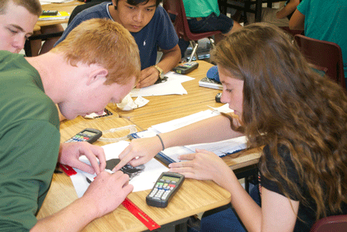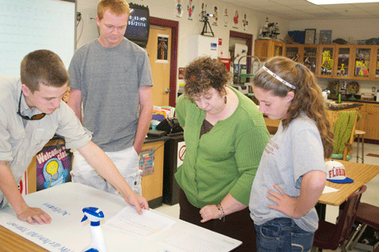Evaluate Alternatives
|
This instructional model emphasizes the evaluation of alternative explanations and the importance of designing a rigorous experiment to test the merits of an explanation. This instructional model, unlike generate an argument, requires access to laboratory equipment, consumables, and a laboratory room. As part of this instructional approach, groups of students test different explanations for a natural phenomenon and then generate, critique, and refine arguments. Each student is also required to write out and submit a final argument to his or her teacher for the purpose of assessment.
This instructional model helps students develop a deeper understanding of core ideas and crosscutting concepts, the role of experiments in science, and experimental design. It also gives students an opportunity to improve their writing and speaking skills in context of science. This model consists of six steps or stages.
Stage 1. Identify the task, the guiding question, and several alternative explanations
The teacher begins an evaluate alternatives activity by identifying a phenomenon to investigate, a guiding question to answer, and several alternative explanations that provide answers to the guiding question. The goal of the teacher at this stage of the model is to capture the students’ interest and provide them with a reason to design and carry out an experiment. This stage of the model highlights the importance of asking questions in science and testing alternative explanations.
The teacher begins an evaluate alternatives activity by identifying a phenomenon to investigate, a guiding question to answer, and several alternative explanations that provide answers to the guiding question. The goal of the teacher at this stage of the model is to capture the students’ interest and provide them with a reason to design and carry out an experiment. This stage of the model highlights the importance of asking questions in science and testing alternative explanations.
|
Stage 2. Design a test and collect data
The teacher groups the students into small research teams. The teams are then directed to design an experiment to evaluate the alternative explanations. The teams then use their method to collect data after the teacher approves it. This stage of Argument-Driven Inquiry gives students an opportunity to learn how to design and carry out an investigation in science. |
Stage 3. Analyze the data and develop an initial argument
Students make sense of the data they collected and then develop a tentative argument. The argument consists of the group’s claim, the evidence they are using to support their claim, and a justification of their evidence. The students should also develop a challenge for at least one of the alternative explanations. This stage of model gives students an opportunity to learn how to analyze and interpret data, use mathematics or computational thinking, critique explanations, and argue from evidence in science.
Students make sense of the data they collected and then develop a tentative argument. The argument consists of the group’s claim, the evidence they are using to support their claim, and a justification of their evidence. The students should also develop a challenge for at least one of the alternative explanations. This stage of model gives students an opportunity to learn how to analyze and interpret data, use mathematics or computational thinking, critique explanations, and argue from evidence in science.
|
Stage 4. Argumentation Session
The goal of the argumentation session is to help students revise and improve their arguments. The students therefore share their arguments and critique the arguments of their classmates. At the end of the argumentation session, each team has an opportunity to revise their arguments in order to make them better. This stage of the model helps students learn how to argue from evidence and how to obtain, evaluate, and communicate information in science. It also helps students develop their oral communication skills. |
Stage #5: The Reflective Discussion
The next step in this instructional model is for the original groups to reconvene and discuss what they learned by interacting with individuals from the other groups. They should then modify their initial argument as needed based on the discussion or, if needed, collect and analyze additional data. After the teacher gives the students a chance to debrief with their group, the teacher should lead a whole class discussion. The teacher should encourage the students to explain what they learned about the phenomenon under investigation and think about ways to improve the nature of their arguments in the future. The teacher should also discuss ways to improve the design of future experiments.
The next step in this instructional model is for the original groups to reconvene and discuss what they learned by interacting with individuals from the other groups. They should then modify their initial argument as needed based on the discussion or, if needed, collect and analyze additional data. After the teacher gives the students a chance to debrief with their group, the teacher should lead a whole class discussion. The teacher should encourage the students to explain what they learned about the phenomenon under investigation and think about ways to improve the nature of their arguments in the future. The teacher should also discuss ways to improve the design of future experiments.
|
Stage #6: The Production of a Final Written Argument
In the last stage of the model, each student is required to produce a written argument in support of one of the explanations that also includes a challenge to an alternative explanation. This stage is included in the instructional model because writing is an important part of doing science. Scientists must be able to read and understand the writing of others as well as evaluate its worth. They also must be able to share the results of their own research through writing. In addition, writing helps students learn how to articulate their thinking in a clear and concise manner, it encourages metacognition, and improves student understanding of the content. |
Learn More:
To learn more about the Evaluate Alternative Instructional Model, see:
Sampson, V. and Gerbino, F. (2010). Two instructional models that teachers can use to promote and support scientific argumentation in the biology classroom. The American Biology Teacher, 72(7), 427-431.
Sampson, V. and Grooms, J. (2009). Promoting and supporting scientific argumentation in the classroom: The evaluate alternatives instructional model. The Science Scope, 33(1), 67-73.
Sampson, V., and Schleigh, S. (2012). Scientific Argumentation in Biology: 30 classroom activities. Arlington, VA: NSTA Press.
Sampson, V. and Grooms, J. (2009). Promoting and supporting scientific argumentation in the classroom: The evaluate alternatives instructional model. The Science Scope, 33(1), 67-73.
Sampson, V., and Schleigh, S. (2012). Scientific Argumentation in Biology: 30 classroom activities. Arlington, VA: NSTA Press.



